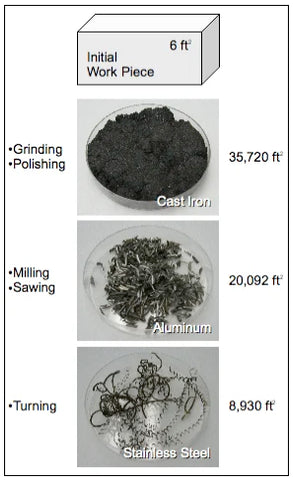Chips are as much of a contaminant in a coolant pool as tramp oil.
They can be chemically damaging, affecting the coolant emulsion. (In this lesson, “emulsion” refers to the mixture of coolant concentrate with water.)
Opposites Attract
Coolant is made up of negatively charged particles while metal, in aqueous solutions, is positively charged. When they interact, metals will attract the coolant’s base oils, leaving less in the coolant emulsion, which reduces lubricity. This effect is similar to that of water hardness on coolant. Depending upon the chip material and size, grease or sludge may form
.

Degree of Metal Destruction
Highly charged metals, such as iron, aluminum, and magnesium will do the most damage to coolant at the chemical level. These metals are each charged with three positive ions, easily disrupting stable emulsions due to their chemical reactivity with the coolant’s negatively charged emulsifying molecule. Steel is moderately destructive since it has less of a charge. Least damaging metals include stainless steel, brass, copper, zinc, and ultra-alloys.

Process Matters
Each machining process will generate chips with particular shape, weight, and size characteristics. These nuances of the metals we machine play a role in how they chemically interact with coolant, the process itself, and how they will be handled for removal.
As seen in the illustration above, at the atomic level, the surface charges of coolant and metal particles react. The surface area of the metal is critical in this regard. The more surface area generated by the machining process, the more surface reactivity can take place. Processes such as grinding and polishing create the smallest size chip, resulting in the largest amount of overall chip surface area. Milling processes create less chip surface area; however the chip particles are still small relative to the size of the initial work piece. Turning creates the largest size chip so poses the least reactivity.
Ground cast iron is highly reactive and does the most damage. As billions of chemical interactions take place, the coolant base oil adheres to the particles creating grease and sludge. What’s left over is unhealthy coolant.
Milled aluminum is less damaging. Although the material is chemically reactive, there is much less surface area for the reactions to take place.
Last, turned steel poses the least threat given the chemical nature of the material as well as the size of the chip generated.

Chip Filtration
The best referee to intervene in the chemical showdown between coolant and chips is filtration. This summary will outline applications in order of simplest to the most aggressive. Large and heavy chips, like apples from a tree, will fall to the ground, or bottom of the tank. As they accumulate, they nominally chemically interact with coolant but also form safe harbors for bacteria and reduce the tank’s fluid capacity. This is easily handled automatically by chip conveyors and augers…easily handled manually by vacuum systems and shovels.
Lighter or smaller chips tend to stay buoyant in the fluid pool. Depending upon the weight of the material, they may circulate with the fluid for some time before nestling with larger chips. While swimming in the coolant, chemically reactive metals will begin to reduce its strength. These are easily captured by bag or cartridge filtration methods, paper bed filters, and if magnetic, magnetic separators. Some may pose danger to submersed pumps, depending upon their size, shape, and quantity.
The tinier chips–those that are near the size (1-50µ) of our champions, the coolant molecules–are ready to take them down. Least damaging materials stay suspended in the fluid and easily circulate within the coolant pool, streaming back to the tool and workpiece to cause worn tooling and poor surface finishes. Staged particle filtration methods are recommended here, reducing filter cleaning or replacement. This kind of particle filtration method offers multiple stages, filtering large size particles such as 100µ first, then 50µ, then 5µ, etc.
The high-strung, most chemically-reactive chips may form grease or sludge (swarf). If the formation sinks, they are best handled by manual filtration methods as given their new solidity, they tend to plug other filtration methods. If they float, they are best captured by coalescers, and readily drained to waste. For cyclone filtration, such as a centrifuge, it is best to check with the coolant manufacturer for recommendations as to their use per application. These systems easily remove solids from fluid, however they may also separate coolant base from the fluid pool.
